- 109

- United States
- PESCAROLOP902
After managing Courage Competition from 1994 to 1998 and, then, after competing as a private team for over a half-dozen years, Henri Pescarolo figured he could do it better. Then, in 2007, Pescarolo announced they would become a manufacturer of prototypes for both the LMP1 and LMP2 categories.
New regulations for 2007 meant the C60 chassis Pescarolo Sport had been using was very quickly becoming obsolete. Henri needed to come up with an answer if he wanted to continue racing the next year. However, Pescarolo was very familiar with the design and manufacturing process after having been with Courage. Having managed his own team for a number of years only further added to his knowledge of what exactly was needed in order to be competitive. Therefore, Henri Pescarolo set out to make his own chassis.
While Pescarolo Sport started out with a clean sheet design, Henri had important real-world experience, and therefore, already had an idea of what design aspects worked, and which ones didn't. In addition, to make an all-new, un-tested design, would have cost much more money. Being the crafty person he is, Henri decided to pull from what he already had available. As a result, Pescarolo's '01' chassis design would end up drawing heavily from Courage's C60, of which Pescarolo Sport was already very familiar.
Henri Pescarolo had managed to stick around Le Mans Series racing despite the dominating presence of Audi. Part of Pescarolo's staying power is attributed to his ability as an owner and manager. He survived the lean years of Le Mans Series racing by recognizing simple, and yet, capable designs and working with them to make them last through the torture of 24 hour endurance racing. He understood having a quick car was important, but a quick car that lasts was of greater paramount. Therefore, he would stick with designs that worked. He then would tweak those designs to make them faster and last longer.
While the nose of the Pescarolo 01 bore striking similarity to the C60, there had been a couple of noticeable revisions to the 01 to aid in improving performance and handling. The leading edge of the front wheel fairings had been updated. The leading edge of the fairing still featured the 'V' shape. The outer-edge of the wheel well was still dramatically contoured inward, in a concave fashion, as the body swept forward toward the front splitter. However, at different times, depending on the track, the leading edge of the front wheel fairings used a convex styling. The convex styling was dropped in favor of the inwardly contoured styling for the 01. This design enabled the use of wing elements with a larger area. The 01chassis sports endplates. Similar to the C60, the endplates, attached to the front splitter, help control airflow over, as well as, under the splitter.
Pescarolo's new 01 sported the raised nose and upward-arcing bodywork over the double wishbone, push-rod suspension. However, the raised nose on the 01actually sat slightly lower than that on the C60. Compared to initial versions of the C60, the nose of the 01 was also revised and made more-pointed. The design of the 01's nose swept up and provided ample coverage over the coils and dampers without having to include bulges in the bodywork. A difference on the top of the 01's nose bodywork was the inclusion of a second rounded hump preceding the cockpit. This helped with smoothing airflow as it passed by the cockpit, which always disrupts airflow dramatically.
The cockpit of the 01 remained an open design. Its design was quite a bit wider than most prototype designs and more a true representation of the rules concerning a prototype capable of seating two occupants. Due to new safety regulations the 01's carbon-fiber moncoque tub structure had to be redone in order to include a second open roll-hoop. Found in the base of the second roll-hoop were the double air-restrictors for the beloved 5.5-liter Judd V10.
To each side of the cockpit were the car's radiator inlets to help provide cooling for the V10 engine. On the side of the car, behind the front tires, there were small shutters designed to help air escape from around the radiator inlet and out the side of the car. This helped to reduce turbulence in the area around the radiator. This also helps to reduce drag as well.
Depending on the team, the cockpit would be laid out differently. In the case of Pescarolo Sport, the driver's office was simple in layout, void of the many other performance features many other larger manufacturer-backed teams had to offer its drivers. The steering wheel was void of many of the buttons and switches used by other teams' drivers to help control functions of the car. Designed for simplicity and reduced-cost operation, the 01 used a simple LCD display, but did feature an XTrac 6-speed sequential gearbox operated by steering wheel mounted paddle-shifters.
Hidden under the bodywork behind the cockpit sits the latest generation of Judd's V10 engine. The Judd engine became a particular favorite of Henri due to its endurance, as well as its power. The newest 5.5-liter version of the popular normally-aspirated V10 actually came with improved torque and fuel economy, which were all important performance upgrades in the battle with the diesels. The engine was capable of producing 640 bhp, and yet, only weighed about 267 pounds.
The rear of the car was virtually identical to the C60. The lines of the bodywork at the side swept back and downward. Near the front of the rear wheels, the bodywork falls-off. This helped direct airflow out around the side of the rear of the car. The low bodywork design created a dramatic rounded rear wheel fairing structure. This, in turn, created a rather deep channel for airflow to the rear end of the car and the rear wing.
The rear wing on the 01 was changed from the design used on the C60. Pescarolo Sport abandoned the complicated wing design used on the previous year's C60 in favor of a more conventional wing. The rear wing on the 01 simply used twin-pillars to support the wing. Gone were the additional vertical structures that once attached to the endplates of the rear wing.
Upon announcement the company was making its own chassis, a number of teams also announced their wish to purchase and run the new chassis. In 2007, Pescarolo Sport entered two of their cars in the LMP1 category. Joining them with a 01 in the LMP1 category as well was Rollcentre Racing. A couple of other racing teams would end up purchasing the chassis with a smaller 3.4-liter V8 Judd to compete in the LMP2 category.
As Pescarolo participated in the 2007 Le Mans Series season, it proved its design was a success as it would consistently run high amongst the petrol-powered cars. Amongst the diesel-powered Audi and Peugeot; however, the performance difference would be noticeable. Although, in its debut, the 01 would make heads turn and cause eyebrows to rise in wonder.
In the 2007 1000km of Monza, the new Pescarolo 01 would put together a fantastic introduction to Le Mans Series racing. At the end of the race, Team Peugeot, and their new diesel-powered 908 HDi would take the victory. However, only one lap down to the Peugeot, Pescarolo's new 01 chassis came home in 2nd place. The second Peugeot 908 finished 3rd. The second Pescarolo 01 followed to finish 4th. The third 01 entered by Rollcentre Racing would end up making three 01 chassis finishing in the top-ten in its debut when it finished 7th.
At the next race of the season, the 1000km of Valencia, Pescarolo 01 chassis finished 4th, 5th and 6th!
After Valencia, the next event the 01 would take part was the 24 Hours of Le Mans. The long straights highlighted the performance differences between the diesels and petrol-powered cars. Despite the short-comings, Pescarolo Sport had one of its cars qualify 6th. The Rollcentre Racing 01 would start an also impressive 8th.
A late bout of rain decimated what was remaining of the entire field. Pescarolo Sports' drivers ran a smart race and avoided huge problems throughout. By the end of the event, Pescarolo's 01 finished a very splendid 3rd. Though eleven laps further down, the Rollcentre Racing 01 finished 4th. The only cars to have beaten the new 01 were the diesel-powered chassis of Audi and Peugeot. The same frustrating results would continue throughout the remainder of the Le Mans Series.
At the Nurburgring, the streak of top-ten finishes was kept alive when Pescarolo Sport managed to have one of its cars finish 3rd, once again following the diesel-powered Peugeots.
Then, at Spa, the two Pescarolo Sport's 01 chassis finished 2nd and 4th. Once again, the only car to beat the 01 was one of the Peugeots.
The situation almost repeated itself when the season travelled to Silverstone for the 1000km race. The end of the race, at the famed race course, saw Peugeot take the victory with its new 908. Following two laps in arrears was Pescarolo Sport's number 16 01 chassis. Finishing another two laps behind the Pescarolo entry was the other team using the 01 chassis, Rollcentre Racing.
In the season's ending race, the very familiar story would repeat itself. Team Peugeot Total would finish the race one-two. Pescarolo Sport was beat out for 3rd by Creation Autosportif driving a CA07 chassis. Pescarolo Sport finished 4th, some twenty laps behind the race winner.
Were it not for the dominant diesel-powered Audis and Peugeots, Pescarolo Sport proved its new 01 chassis was the class of the field in 2007. Overshadowed by the presence of the diesels and the importance of winning races, the 01 more than showed it was a competent racing machine. It provided customers with a car capable of elite levels of performance within a budget.
'2007 Pescarolo 01', (http://www.supercars.net/cars/4491.html). Supercars.net. http://www.supercars.net/cars/4491.html. Retrieved 26 January 2011.
Wikipedia contributors, 'Pescarolo 01', Wikipedia, The Free Encyclopedia, 25 December 2010, 20:05 UTC, http://en.wikipedia.org/w/index.php?title=Pescarolo_01&oldid=404203272 accessed 26 January 2011
'Pescarolo 01 LMP1 Judd', (http://www.ultimatecarpage.com/car/3187/Pescarolo-01-LMP1-Judd.html). Ultimatecarpage.com: Powered by Knowledge, Driven by Passion. http://www.ultimatecarpage.com/car/3187/Pescarolo-01-LMP1-Judd.html. Retrieved 26 January 2011.
'Pescarolo Courage C60 Hybrid Judd', (http://www.ultimatecarpage.com/pic/2319/Pescarolo-Courage-C60-Hybrid-Judd_5.html). Ultimatecarpage.com: Powered by Knowledge, Driven by Passion. http://www.ultimatecarpage.com/pic/2319/Pescarolo-Courage-C60-Hybrid-Judd_5.html. Retrieved 26 January 2011.
Wikipedia contributors, '2007 Le Mans Series season', Wikipedia, The Free Encyclopedia, 23 October 2010, 13:30 UTC, http://en.wikipedia.org/w/index.php?title=2007_Le_Mans_Series_season&oldid=392400892 accessed 26 January 2011
Wikipedia contributors, '2007 24 Hours of Le Mans', Wikipedia, The Free Encyclopedia, 24 January 2011, 23:00 UTC, http://en.wikipedia.org/w/index.php?title=2007_24_Hours_of_Le_Mans&oldid=409851797 accessed 26 January 2011
By Jeremy McMullen- www.Conceptcarz.com
2007 Pescarolo 01 Specifications
Engine Location: Mid
Drive Type: Rear Wheel
Body / Chassis: Carbon fibre monocoque
Weight: 1984 lbs | 899.927 kg
Engine Type : V10 5496 cc | 335.4 cu in. | 5.5 L.
650 BHP (478.4 KW) @ 7000 RPM
484 Ft-Lbs (657 NM)
V10 335
Transmission:
6 Sequential X-Trac
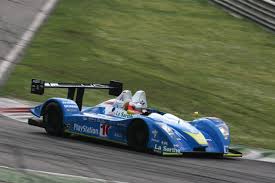

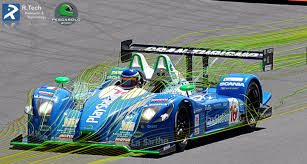
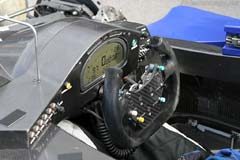
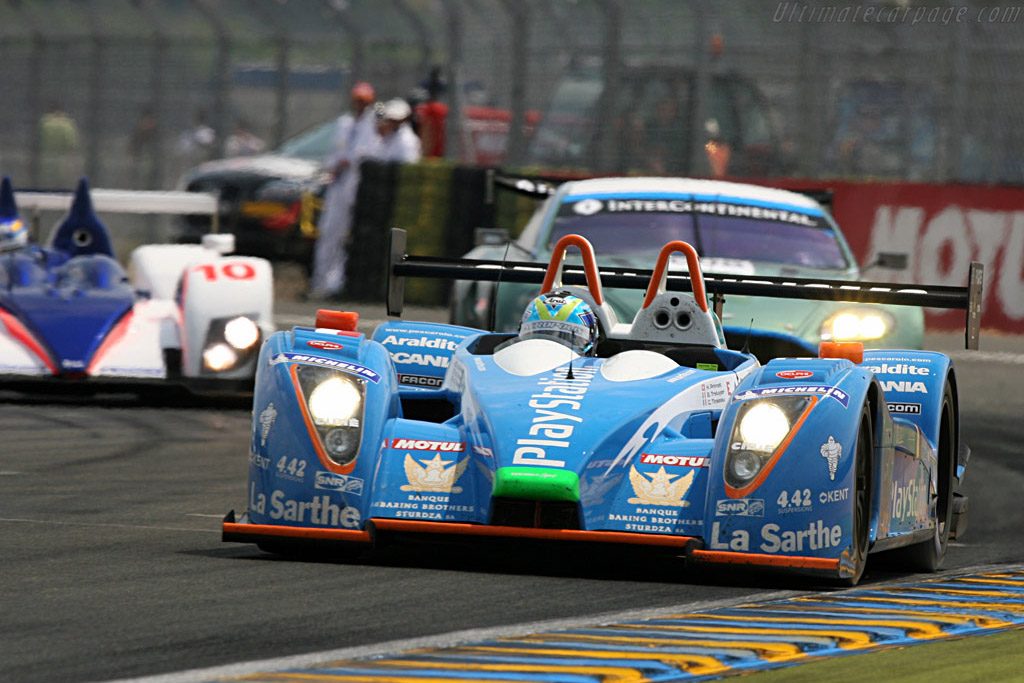
Thanks to LEFT: Henri Pescarolo and RIGHT: Pescarolo Sport
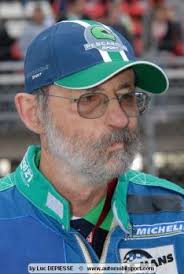
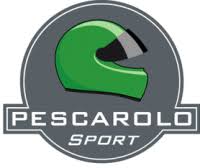
New regulations for 2007 meant the C60 chassis Pescarolo Sport had been using was very quickly becoming obsolete. Henri needed to come up with an answer if he wanted to continue racing the next year. However, Pescarolo was very familiar with the design and manufacturing process after having been with Courage. Having managed his own team for a number of years only further added to his knowledge of what exactly was needed in order to be competitive. Therefore, Henri Pescarolo set out to make his own chassis.
While Pescarolo Sport started out with a clean sheet design, Henri had important real-world experience, and therefore, already had an idea of what design aspects worked, and which ones didn't. In addition, to make an all-new, un-tested design, would have cost much more money. Being the crafty person he is, Henri decided to pull from what he already had available. As a result, Pescarolo's '01' chassis design would end up drawing heavily from Courage's C60, of which Pescarolo Sport was already very familiar.
Henri Pescarolo had managed to stick around Le Mans Series racing despite the dominating presence of Audi. Part of Pescarolo's staying power is attributed to his ability as an owner and manager. He survived the lean years of Le Mans Series racing by recognizing simple, and yet, capable designs and working with them to make them last through the torture of 24 hour endurance racing. He understood having a quick car was important, but a quick car that lasts was of greater paramount. Therefore, he would stick with designs that worked. He then would tweak those designs to make them faster and last longer.
While the nose of the Pescarolo 01 bore striking similarity to the C60, there had been a couple of noticeable revisions to the 01 to aid in improving performance and handling. The leading edge of the front wheel fairings had been updated. The leading edge of the fairing still featured the 'V' shape. The outer-edge of the wheel well was still dramatically contoured inward, in a concave fashion, as the body swept forward toward the front splitter. However, at different times, depending on the track, the leading edge of the front wheel fairings used a convex styling. The convex styling was dropped in favor of the inwardly contoured styling for the 01. This design enabled the use of wing elements with a larger area. The 01chassis sports endplates. Similar to the C60, the endplates, attached to the front splitter, help control airflow over, as well as, under the splitter.
Pescarolo's new 01 sported the raised nose and upward-arcing bodywork over the double wishbone, push-rod suspension. However, the raised nose on the 01actually sat slightly lower than that on the C60. Compared to initial versions of the C60, the nose of the 01 was also revised and made more-pointed. The design of the 01's nose swept up and provided ample coverage over the coils and dampers without having to include bulges in the bodywork. A difference on the top of the 01's nose bodywork was the inclusion of a second rounded hump preceding the cockpit. This helped with smoothing airflow as it passed by the cockpit, which always disrupts airflow dramatically.
The cockpit of the 01 remained an open design. Its design was quite a bit wider than most prototype designs and more a true representation of the rules concerning a prototype capable of seating two occupants. Due to new safety regulations the 01's carbon-fiber moncoque tub structure had to be redone in order to include a second open roll-hoop. Found in the base of the second roll-hoop were the double air-restrictors for the beloved 5.5-liter Judd V10.
To each side of the cockpit were the car's radiator inlets to help provide cooling for the V10 engine. On the side of the car, behind the front tires, there were small shutters designed to help air escape from around the radiator inlet and out the side of the car. This helped to reduce turbulence in the area around the radiator. This also helps to reduce drag as well.
Depending on the team, the cockpit would be laid out differently. In the case of Pescarolo Sport, the driver's office was simple in layout, void of the many other performance features many other larger manufacturer-backed teams had to offer its drivers. The steering wheel was void of many of the buttons and switches used by other teams' drivers to help control functions of the car. Designed for simplicity and reduced-cost operation, the 01 used a simple LCD display, but did feature an XTrac 6-speed sequential gearbox operated by steering wheel mounted paddle-shifters.
Hidden under the bodywork behind the cockpit sits the latest generation of Judd's V10 engine. The Judd engine became a particular favorite of Henri due to its endurance, as well as its power. The newest 5.5-liter version of the popular normally-aspirated V10 actually came with improved torque and fuel economy, which were all important performance upgrades in the battle with the diesels. The engine was capable of producing 640 bhp, and yet, only weighed about 267 pounds.
The rear of the car was virtually identical to the C60. The lines of the bodywork at the side swept back and downward. Near the front of the rear wheels, the bodywork falls-off. This helped direct airflow out around the side of the rear of the car. The low bodywork design created a dramatic rounded rear wheel fairing structure. This, in turn, created a rather deep channel for airflow to the rear end of the car and the rear wing.
The rear wing on the 01 was changed from the design used on the C60. Pescarolo Sport abandoned the complicated wing design used on the previous year's C60 in favor of a more conventional wing. The rear wing on the 01 simply used twin-pillars to support the wing. Gone were the additional vertical structures that once attached to the endplates of the rear wing.
Upon announcement the company was making its own chassis, a number of teams also announced their wish to purchase and run the new chassis. In 2007, Pescarolo Sport entered two of their cars in the LMP1 category. Joining them with a 01 in the LMP1 category as well was Rollcentre Racing. A couple of other racing teams would end up purchasing the chassis with a smaller 3.4-liter V8 Judd to compete in the LMP2 category.
As Pescarolo participated in the 2007 Le Mans Series season, it proved its design was a success as it would consistently run high amongst the petrol-powered cars. Amongst the diesel-powered Audi and Peugeot; however, the performance difference would be noticeable. Although, in its debut, the 01 would make heads turn and cause eyebrows to rise in wonder.
In the 2007 1000km of Monza, the new Pescarolo 01 would put together a fantastic introduction to Le Mans Series racing. At the end of the race, Team Peugeot, and their new diesel-powered 908 HDi would take the victory. However, only one lap down to the Peugeot, Pescarolo's new 01 chassis came home in 2nd place. The second Peugeot 908 finished 3rd. The second Pescarolo 01 followed to finish 4th. The third 01 entered by Rollcentre Racing would end up making three 01 chassis finishing in the top-ten in its debut when it finished 7th.
At the next race of the season, the 1000km of Valencia, Pescarolo 01 chassis finished 4th, 5th and 6th!
After Valencia, the next event the 01 would take part was the 24 Hours of Le Mans. The long straights highlighted the performance differences between the diesels and petrol-powered cars. Despite the short-comings, Pescarolo Sport had one of its cars qualify 6th. The Rollcentre Racing 01 would start an also impressive 8th.
A late bout of rain decimated what was remaining of the entire field. Pescarolo Sports' drivers ran a smart race and avoided huge problems throughout. By the end of the event, Pescarolo's 01 finished a very splendid 3rd. Though eleven laps further down, the Rollcentre Racing 01 finished 4th. The only cars to have beaten the new 01 were the diesel-powered chassis of Audi and Peugeot. The same frustrating results would continue throughout the remainder of the Le Mans Series.
At the Nurburgring, the streak of top-ten finishes was kept alive when Pescarolo Sport managed to have one of its cars finish 3rd, once again following the diesel-powered Peugeots.
Then, at Spa, the two Pescarolo Sport's 01 chassis finished 2nd and 4th. Once again, the only car to beat the 01 was one of the Peugeots.
The situation almost repeated itself when the season travelled to Silverstone for the 1000km race. The end of the race, at the famed race course, saw Peugeot take the victory with its new 908. Following two laps in arrears was Pescarolo Sport's number 16 01 chassis. Finishing another two laps behind the Pescarolo entry was the other team using the 01 chassis, Rollcentre Racing.
In the season's ending race, the very familiar story would repeat itself. Team Peugeot Total would finish the race one-two. Pescarolo Sport was beat out for 3rd by Creation Autosportif driving a CA07 chassis. Pescarolo Sport finished 4th, some twenty laps behind the race winner.
Were it not for the dominant diesel-powered Audis and Peugeots, Pescarolo Sport proved its new 01 chassis was the class of the field in 2007. Overshadowed by the presence of the diesels and the importance of winning races, the 01 more than showed it was a competent racing machine. It provided customers with a car capable of elite levels of performance within a budget.
'2007 Pescarolo 01', (http://www.supercars.net/cars/4491.html). Supercars.net. http://www.supercars.net/cars/4491.html. Retrieved 26 January 2011.
Wikipedia contributors, 'Pescarolo 01', Wikipedia, The Free Encyclopedia, 25 December 2010, 20:05 UTC, http://en.wikipedia.org/w/index.php?title=Pescarolo_01&oldid=404203272 accessed 26 January 2011
'Pescarolo 01 LMP1 Judd', (http://www.ultimatecarpage.com/car/3187/Pescarolo-01-LMP1-Judd.html). Ultimatecarpage.com: Powered by Knowledge, Driven by Passion. http://www.ultimatecarpage.com/car/3187/Pescarolo-01-LMP1-Judd.html. Retrieved 26 January 2011.
'Pescarolo Courage C60 Hybrid Judd', (http://www.ultimatecarpage.com/pic/2319/Pescarolo-Courage-C60-Hybrid-Judd_5.html). Ultimatecarpage.com: Powered by Knowledge, Driven by Passion. http://www.ultimatecarpage.com/pic/2319/Pescarolo-Courage-C60-Hybrid-Judd_5.html. Retrieved 26 January 2011.
Wikipedia contributors, '2007 Le Mans Series season', Wikipedia, The Free Encyclopedia, 23 October 2010, 13:30 UTC, http://en.wikipedia.org/w/index.php?title=2007_Le_Mans_Series_season&oldid=392400892 accessed 26 January 2011
Wikipedia contributors, '2007 24 Hours of Le Mans', Wikipedia, The Free Encyclopedia, 24 January 2011, 23:00 UTC, http://en.wikipedia.org/w/index.php?title=2007_24_Hours_of_Le_Mans&oldid=409851797 accessed 26 January 2011
By Jeremy McMullen- www.Conceptcarz.com
2007 Pescarolo 01 Specifications
Engine Location: Mid
Drive Type: Rear Wheel
Body / Chassis: Carbon fibre monocoque
Weight: 1984 lbs | 899.927 kg
Engine Type : V10 5496 cc | 335.4 cu in. | 5.5 L.
650 BHP (478.4 KW) @ 7000 RPM
484 Ft-Lbs (657 NM)
V10 335
Transmission:
6 Sequential X-Trac


Thanks to LEFT: Henri Pescarolo and RIGHT: Pescarolo Sport
Last edited:

 👍
👍
